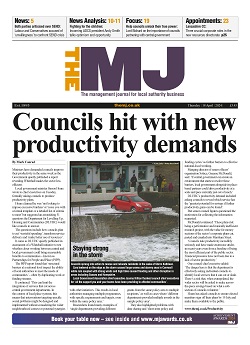The pandemic response has demonstrated just how much the centre is inclined to tighten its grip in the face of a crisis – a governance feature councils have wrestled with for decades and which Number 10 has doubled down on since March. For many, increasingly beyond the sector itself, this has highlighted the need for more power and resource to be given to local government – which has shown enormous capacity to deal with this crisis.
But it has also revealed an aspect of our system which hasn’t been in sharp focus to date: connectivity between central and local tiers of government is barely functional.
This lack of connectivity has undermined the ability of our system to flex and respond to the crisis. In the early unfolding months of the pandemic, the Department of Health and Social Care (DHSC) didn’t even have a list of email addresses for directors of public health, so absent was any prior relationship between them. The MJ reported in May how local resilience forums felt lack of communication and withholding data by Government had hampered their ability to respond.
The Government is used to operating in broadcast mode – instructing localities formally with regulations and guidance, rather than engaging in ongoing dialogue. It isn’t institutionally equipped to conduct more sophisticated and multiple relationships that might involve receiving and responding to intelligence ‘from the ground’ back up the system.
This means the capacity and expertise of local government is persistently overlooked, to the detriment of our pandemic response. The Government’s micromanaging instincts cannot cope with connecting to 343 different local entities: it is far simpler to sustain one single contractual relationship with a big provider. So where local knowledge and insight would make all the difference, this resource is not leveraged to its full potential – and our test, track and trace system is the weaker for it. If there is a choice between an effective system the Government cannot control and an ineffective system that they can, the latter wins.
Beyond the pandemic, the perceived complexity of local government is undoubtedly a driver behind the mooted reorganisation of two-tier areas. Yet from the perspective of local government, it isn’t always obvious who to talk to in Whitehall either. There is no ‘single view’ of local government in SW1. Nominally the Ministry of Housing, Communities and Local Government (MHCLG) has responsibility for councils, but core top tier functions are overseen by other departments – notably adult social care in the DHSC and children’s social care in the Department for Education (DfE). Ask the MHCLG about children’s services and they refer you to troubled families, which is their ‘thing’. Mention budget constraints to a DfE official and you can expect a blank look – that’s a Treasury matter, via the MHCLG.
This institutional blindspot for what local government actually does in its entirety reflects an important element of our connectivity dysfunction: the separation of policy and practice. The business of the civil service is policy development – often without early engagement of the frontline who will need to implement decisions. Consultations happen late in the process if at all, with fixed parameters. Decisions will be politically stress-tested, but not assessed for practical feasibility. Delivery capability amongst civil servants is limited – career progression is based more on internal expertise than external experience. This cements a culture within Whitehall that it is above and apart from local government – a higher tier of governance rather than simply a separate sphere.
In the heat of the crisis, a new cadre of local government experts have been drawn into DHSC to take on temporary coordination and liaison roles – this has been positive but much more needs to be done to create robust connectivity in culture and practice throughout the system. Whitehall needs to develop its policy radar beyond its buildings and recognise the expertise of localities as a valuable commodity in shaping practical policy. This can be done through recruiting more personnel with delivery experience, creating better forums for ongoing dialogue and more open policy-making processes.
The arguments for more devolution will persist, but those of us who advocate for it shouldn’t focus solely on a zero-sum wrangle for power. Local government also needs more effective routes to influence national decisions and ensure these reflect local insights and capacity. Without stronger connectivity between the centre and localities, the latter will constantly be on the back foot, with the former plunging from crisis to crisis, the inevitable result of ill-informed policy-making crashing into the reality of delivery in practice.
Jessica Studdert is deputy director of the New Local Government Network

